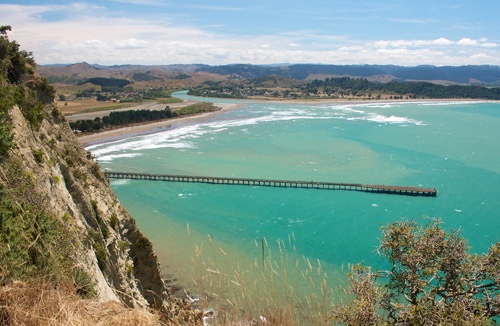
Tolaga Bay Wharf (1929)
A pier without peer
A drive around East Cape will reveal the crumbling remains of three massive piers, at Tolaga, Tokomaru and Hicks Bays. They are remarkably close together – Tolaga, the southernmost, is just over 50 km from Gisborne and less than 40 km from Tokomaru – and they are relatively recent, 20th-century structures. Yet before modern sealed roads, road transport was impractical and the huge piers were vital lifelines. Out went meat, wool and livestock and in came cased petrol, kegs of beer and general merchandise.
Earlier in the 20th century farmers erected a small wharf in the mouth of the Ūawa River to load cargo into lighters servicing ships anchored in the bay. It had silted up by the end of the First World War, when moves to establish a freezing works and reluctance to pay rates for Gisborne’s harbour works revived local interest in a port. Marine engineer Cyrus Williams drew up plans for a 100-m wharf connected to the shore by a 500-m jetty. Although he estimated the work would cost a staggering £60,000 (equivalent to more than $5 million in 2013), the tiny community approved a £100,000 loan, raised £70,000 and gave builder Fred Goodman the contract.
Work started in January 1926 and soon confirmed the doubters’ misgivings. The approachway had to be shifted during construction and the final wharf offered just 5.2 m depth instead of the 6.4 m expected. Storm damage in 1928 forced the harbour board to borrow £20,000 more. Nevertheless everyone smiled on 22 November 1929 when the Minister of Marine turned up to open the wharf. The farmer-owned firm Geo. H. Scales broke ranks with the British-owned Conference Lines that controlled our trade with the UK and loaded direct from Tolaga Bay, sending its ‘Conference buster’ Bencruachan there in December 1929 to tranship from coasters. In 1936, 133 ships worked the port. But that was the high point. Scales continued to send ships until wartime centralisation ended calls from the big ‘Home boats’.
After the war only coasters called, and too few of them to pay for the maintenance of the deteriorating ferro-cement piles. Richardson & Co.’s Kopara made the last call in 1966, five years after the harbour board was wound up. Now only pedestrians use the wharf, although they do it in such numbers that it has become one of the area’s biggest attractions. In 1999 locals formed the Tolaga Bay Save The Wharf Charitable Trust to preserve the wharf. Much remains to be done, but already this century the two stages of repair work have made noticeable improvements.
Further information
This site is item number 86 on the History of New Zealand in 100 Places list.
Websites
Books
- John O’C. Ross, Pride in their ports, Dunmore Press, Palmerston North, 1977





Community contributions